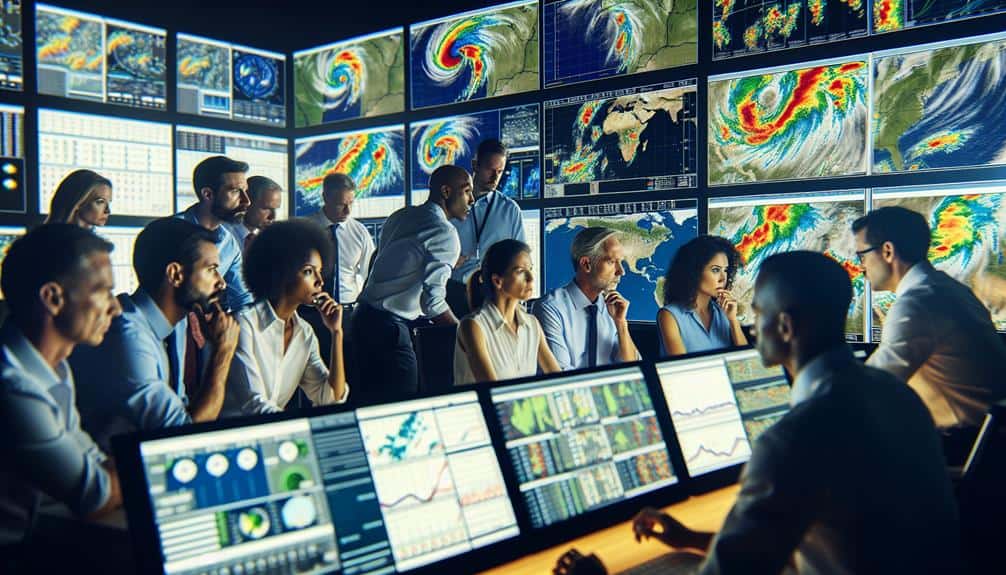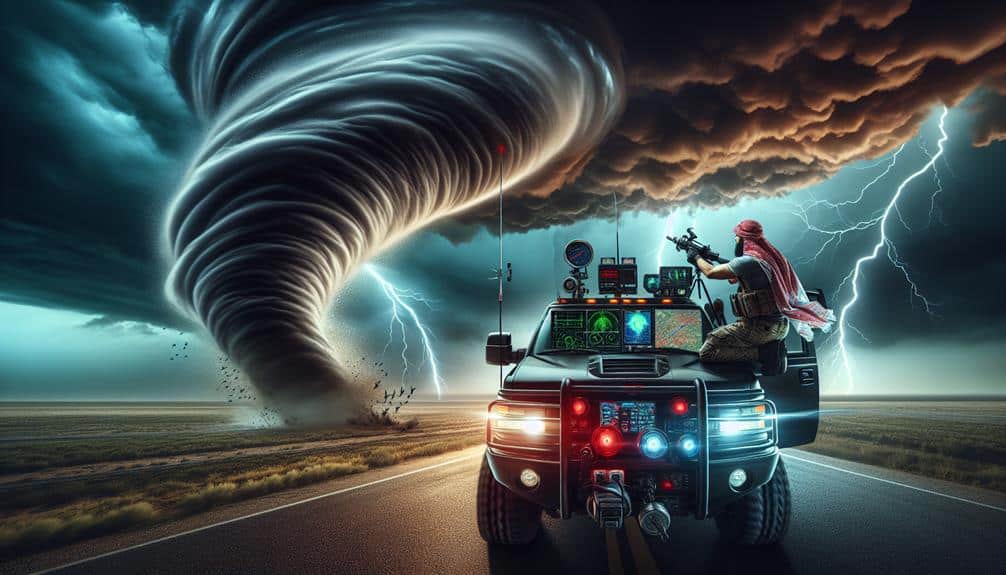We must communicate risk findings to our storm chasers through precise, data-driven communication. Utilizing risk metrics like probability of severe weather, wind speed, and precipitation intensity, we can inform rapid decisions. Real-time updates and advanced meteorological tools such as satellite imagery and Doppler radar enhance situational awareness. Data visualization tools, including heat maps and interactive maps, make the data actionable. We tailor our messaging for clarity using infographics, bullet points, and color-coded levels. Post-chase analysis, with thorough discussion and feedback, refines our strategies further. We'll explore how these approaches guarantee safety and effectiveness in high-stakes environments.
Key Points
- Utilize real-time data visualization tools to present complex risk metrics clearly and quickly.
- Implement color-coded risk levels and infographics for immediate understanding of severe weather conditions.
- Provide continuous real-time updates integrating satellite imagery, Doppler radar, and pressure data for accurate situational awareness.
- Tailor communication strategies with succinct messages highlighting immediate risks and required actions.
Understanding Risk Metrics
Understanding risk metrics is crucial for our storm chasers team to accurately evaluate and respond to potential hazards. By interpreting various risk metrics, we convert raw data into actionable insights. These metrics include probability of severe weather occurrences, wind speed forecasts, and precipitation intensity. Accurate risk interpretation allows us to make informed decisions quickly, guaranteeing our safety and effectiveness in the field.
We rely on data visualization techniques to present complex risk metrics in a clear and understandable manner. Graphs, heat maps, and time-series plots transform numerical data into visual formats, enabling us to grasp trends and patterns at a glance. For example, a heat map illustrating tornado probabilities across regions helps us prioritize our deployment areas. This visual approach not only enhances our situational awareness but also aids in rapid decision-making under pressure.
Our dedication to mastering risk metrics and data visualization empowers us to navigate storm environments with precision. We embrace these tools to maintain our operational freedom, making certain we're always a step ahead of potential threats. By integrating these techniques, we guarantee that our risk assessments are both scientifically rigorous and practically applicable.
Tools for Risk Visualization
To effectively interpret and communicate risk metrics, we utilize sophisticated tools for risk visualization that transform raw data into actionable insights. These tools are essential for storm chasers, who require precise and dynamic information to make real-time decisions. One of our primary tools is interactive maps, which allow us to geographically represent risk data, enabling the team to visualize potential storm paths, intensity zones, and affected areas. These maps are updated in real-time, providing timely data that's vital for tactical adjustments.
In addition to interactive maps, we employ advanced data visualization techniques. These include heat maps, scatter plots, and temporal graphs that display trends and correlations in the risk data. By converting complex datasets into visually intuitive formats, we can quickly convey the severity and likelihood of various storm scenarios. This approach not only enhances situational awareness but also fosters a deeper understanding of the underlying risk factors.
Through these tools, we can distill vast amounts of information into clear, actionable insights. Our goal is to empower the storm chasers with the freedom to navigate and interpret risk data effectively, ensuring they can make informed decisions when it matters most.
Tailoring Communication Strategies
How can we effectively tailor our communication strategies to guarantee storm chasers receive clear, concise, and actionable risk information?
The key lies in conducting thorough audience analysis. By understanding the specific needs, preferences, and expertise levels of our storm chasers, we can customize our messaging for maximum impact. We must leverage precise language and avoid jargon that could cause confusion.
Communication techniques are critical in this effort. Real-time data visualization tools, for example, can help us convey complex meteorological data in an easily digestible format. Infographics, bullet points, and color-coded risk levels can enhance clarity. In addition, succinct, focused messages that highlight immediate risks and recommended actions are essential.
Moreover, we should employ feedback mechanisms to continually refine our approach. Surveys and direct feedback from storm chasers can provide valuable insights into the effectiveness of our strategies. By iteratively improving our communication techniques, we guarantee our messages remain relevant and impactful.
Real-Time Risk Updates
Real-time danger updates provide storm chasers with the most current and critical data, enabling them to make informed decisions on the fly. By leveraging advanced meteorological instruments, we guarantee that our team notifications are both timely and accurate. This immediate access to data is essential for emergency response, allowing us to react swiftly to evolving storm conditions.
Our decision-making process hinges on the reliability of these updates. We integrate satellite imagery, Doppler radar readings, and atmospheric pressure data to create a thorough risk profile. This integration facilitates precise and actionable insights, ensuring our safety measures are always based on the latest information.
Every second counts in the field, and our ability to interpret and act on real-time data can make the difference between a successful chase and a dangerous encounter.
Moreover, continuous updates empower us with the freedom to adapt our strategies dynamically. As conditions shift, so too can our approach, minimizing risk and maximizing efficiency. By prioritizing real-time communication, we enhance our collective situational awareness, ensuring that each team member is informed and prepared.
This robust system of real-time danger updates is the cornerstone of our operational safety and effectiveness.
Post-Chase Risk Analysis

After each chase, we meticulously analyze the data to assess the risks encountered and refine our future strategies. Our post-chase evaluation process starts by aggregating all observational data, including wind speeds, radar imagery, and video footage. We look at each variable's correlation with the risks faced in real-time.
During our risk assessment phase, we quantify the likelihood of encountering specific hazards, such as tornadoes, hail, or lightning. By using statistical models, we convert qualitative observations into actionable metrics. This approach allows us to identify patterns and anomalies, guaranteeing our team can make data-driven decisions in future chases.
Communication is key in this process. We compile our findings into concise reports, highlighting critical risk factors and suggesting mitigative strategies. These reports are shared with the entire team, fostering a culture of continuous improvement. We also hold debrief sessions to discuss the findings openly, encouraging feedback and diverse perspectives.
Our scientific rigor ensures that each post-chase evaluation is thorough yet efficient. By focusing on data integrity and clear communication, we empower our team to operate with greater freedom and confidence, knowing that our strategies are grounded in robust risk assessments.
Frequently Asked Questions
How Can We Improve Our Team's Response to Unexpected Changes in Storm Patterns?
To enhance our team's response to unexpected changes in storm patterns, we must improve emergency response protocols, optimize team coordination processes, and implement real-time data analytics. Leveraging these strategies guarantees rapid, informed, and precise decision-making.
What Are the Best Practices for Briefing New Team Members on Risk Protocols?
We should use data-driven training techniques focusing on risk management to brief new members. Effective team integration and emergency response protocols will guarantee they're prepared for all scenarios. This approach maximizes their autonomy while guaranteeing safety.
How Should We Handle Conflicting Risk Assessments From Different Sources?
When handling disagreements in risk assessments, we should act as the compass, guiding through varied findings. Resolving conflicts requires analyzing data with scientific rigor, ensuring our route is clear, precise, and rooted in freedom-driven decision-making.
What Measures Should We Take to Ensure Our Communication Devices Remain Functional During Storms?
We should establish emergency protocols and guarantee technology resilience by deploying communication redundancy. Utilizing weatherproof devices and regularly testing them will maintain functionality during storms, guaranteeing we stay connected and informed in all conditions.
How Can We Integrate Social Media Updates Into Our Real-Time Risk Communication Strategy?
We can integrate social media updates into our real-time risk communication strategy by leveraging APIs for instantaneous data sharing. This guarantees storm chasers receive accurate risk communication continuously, maximizing their freedom to make informed decisions.


